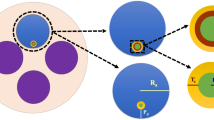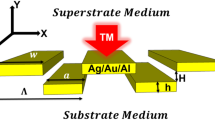Abstract
Here, we indicate that metasurface-based biosensors consisting of silver-metasurface with SiO2 and working in the near-infrared (NIR) spectral range can obtain simultaneous high-sensitivity and high-tunable detection of biomaterials including ether with n = 1.3, ethylene glycol with n = 1.4, chlorobenzene with n = 1.5, and quinolone with n = 1.6, where n is refractive index. Using 3D-FDTD method, we numerically extract the optical characteristics of the metasurface sensor and validate by quasi analytic coupled mode theory (CMT). By changing the refractive index of the dielectric layer, maximum sensitivity equal to 658 nm/RIU for Δn = 0.25 is achieved, so it can be able to use in high sensitive plasmonic sensors. Also the results show that the proposed metasurface sensor can be used as a multi-usage structure, such as biomaterial distinguish and identify TE and TM polarization at 40° incident angle (anisotropy in TE mode absorption spectra). Moreover by using silver as the metal layer, maximum and minimum group indexes are achieved as 350 and 486, respectively, so it is a good choice to utilize in harnessing of slow/fast light propagation. The overall size of the sensor is 540 nm × 540 nm × 560 nm, hence is a proper candidate for nanoscale sensor.








Similar content being viewed by others
Data Availability
All data included in this paper are available upon request by contact with the contact corresponding author.
References
Luo X, Tsai D, Gu M, Hong M (2009) Extraordinary optical fields in nanostructures: from sub-diffraction-limited optics to sensing and energy conversion. Chem Soc Rev (8)
Xu Y et al (2019) Optical refractive index sensors with plasmonic and photonic structures: promising and inconvenient truth. Adv Opt Mater 1801433
Popescu VA (2019) Application of a plasmonic biosensor for detection of human blood groups. Plasmonics 12(6):1733–1739
Etezadi D et al (2017) Nanoplasmonic mid-infrared biosensor for in vitro protein secondary structure detection. Light Sci Appl: 1–10
Taghipour YD, Kharrazi S, Amini SM (2018) Antibody Conjugated Gold Nanoparticles for Detection of Small Amounts of Antigen Based on Surface Plasmon Resonance (SPR) Spectra. Nanomed Res J 3(2):102–108
Sugumaran S et al (2018) Nanostructured materials with plasmonic nanobiosensors for early cancer detection: a past and future prospect. Biosens Bioelectron 100(15):361–373
Altintas Z (2018) Surface plasmon resonance based sensor for the detection of glycopeptide antibiotics in milk using rationally designed nanoMIPs. Sci Rep
Ma W et al (2013) Chloroform-sensing properties of plasmonic nanostructures using poly (methyl methacrylate) transduction layer. Micro Nano Lett 8(2):1750–0443
Zhang X et al (2013) Hydrogen peroxide and glucose concentration measurement using optical fiber grating sensors with corrodible plasmonic nanocoatings. Biomed Opt Express 9(4):1735–1744
Ding F et al (2018) A review of gap-surface plasmon metasurfaces: fundamentals and applications. Nanophotonics 7(6):1129–1156
Farmani A, Mir A (2019) Graphene Sensor based on Surface Plasmon Resonance for Optical Scanning. IEEE Photon Technol Lett 31(8):643–646
Baqir MA et al (2018) Nanoscale, tunable, and highly sensitive biosensor utilizing hyperbolic metamaterials in the near-infrared range. Appl Opt 57(31):9447–9454
Alipour A, Farmani A, Mir A (2018) High sensitivity and tunable nanoscale sensor based on plasmon-induced transparency in plasmonic metasurface. IEEE Sensors J 18(17):7047–7054
Rakhshani MR, Tavousi A, Mansouri-Birjandi MA (2018) Design of a plasmonic sensor based on a square array of nanorods and two slot cavities with a high figure of merit for glucose concentration monitoring. Appl Opt 57(27):7798–7804
Ghorbani S, Dashti MA, Jabbari M (2018) Plasmonic nano-sensor based on metal-dielectric-metal waveguide with the octagonal cavity ring. Laser Phys 28(6):1–6
Topcu G et al (2019) Colorimetric and Plasmonic Pressure Sensors based on Polyacrylamide/Au Nanoparticles. Sensors Actuators A Phys
Chang Y, Jiang Y (2014) Highly sensitive plasmonic sensor based on Fano resonance from silver nanoparticle heterodimer array on a thin silver film. Plasmonics 9(3):499–504
Alipour AH, Mir A (2019) Design and simulation of a high-selective plasmon-induced reflectance in coupled dielectric-metal-dielectric nano-structure for senor devices and slow light propagation. Plasmonics 14(2):511–521
Lin H-I et al (2018) Transient and Flexible Hyperbolic Metamaterials on Freeform Surfaces. Sci Rep
Emami-Nejad H, Mir A (2017) Design and simulation of a flexible and ultra-sensitive biosensor based on frequency selective surface in the microwave range. Opt Quant Electron
Mehrotra P, Chatterjee B, Sen S (2019) EM-wave biosensors: a review of RF, microwave, mm-wave and optical sensing. Sensors 19(5)
Hong JT et al (2018) Enhanced sensitivity in THz plasmonic sensors with silver nanowires. Sci Rep
Sachet E et al (2015) Dysprosium-doped cadmium oxide as a gateway material for mid-infrared plasmonics. Nat Mater
Farmani A (2019) Three-dimensional FDTD analysis of a nanostructured plasmonic sensor in the near-infrared range. JOSA B 36(2):401–407
Zografopoulos DC, Swillam M, Beccherelli R (2016) Hybrid plasmonic modulators and filters based on electromagnetically induced transparency. IEEE Photon Technol Lett 28(7):818–821
Zhang Z et al (2018) All-optical multi-channel switching at telecommunication wavelengths based on tunable plasmon-induced transparency. Opt Commun 425(15):196–203
Song H-J et al (2019) Optical and electrical effects of nanobump structure combined with an undulated active layer on plasmonic organic solar cells. Org Electron 71:136–142
Vafapour Z (2019) Large group delay in a microwave metamaterial analog of electromagnetically induced reflectance. JOSA A 35(3):417–422
Keshavarz A, Vafapour Z (2019) Thermo-optical applications of a novel terahertz semiconductor metamaterial design. JOSA B 36(1):35–41
Cheng Y et al (2019) Triple narrow-band plasmonic perfect absorber for refractive index sensing applications of optical frequency. OSA Continuum 2(7):2113–2122
Jing N et al (2019) Refractive index sensing based on a side-polished macrobend plastic optical fiber combining surface plasmon resonance and macrobending loss. IEEE Sensors J 19(14):5665–5669
Yi Y et al (2019) Effect of external resistance on the sensitivity of microbial fuel cell biosensor for detection of different types of pollutants. Bioelectrochemistry 125:717–778
Javahiraly N, Cyabaka C, Brioude A (2019) Plasmonic optical systems for gas detection. Quantum Sensing and Nano Electronics and Photonics XVI
Shukla GM et al (2019) Optimization of plasmonic u-shaped optical fiber sensor for mercury ions detection using glucose capped silver nanoparticles. IEEE Sensors J 19(9):3224–3231
Mu Y, et al (2019) Sensing characteristics of the gold-silver alloy waveguided metallic photonic crystals. 9th International Symposium on Advanced Optical Manufacturing and Testing Technologies: Micro-and Nano-Optics, Catenary Optics, and Subwavelength Electromagnetics. 10840. International Society for Optics and Photonics
Tung BS, Khuyen BX, Kim YJ, Lam VD, Kim KW, Lee YP (2017) Polarization-independent, wide incident-angle and dual-band perfect absorption, based on near-field coupling in a symmetric metamaterial. Sci Rep 7:11507
NguyenLe L, Thang NM, Thuy LM, Tung NT (2017) Hybrid semiconductor–dielectric metamaterial modulation for switchable bi-directional THz absorbers. Opt Commun 385(15):244–249
Chen X, Gong H, Dai S et al (2013) Near-infrared broadband absorber with film-coupled multilayer nanorod. Opt Lett 38(13):2447–2249
Rakhshani MR, Mansouri-Birjandi MA (2018) Engineering Hexagonal Array of Nanoholes for High Sensitivity Biosensor and Application for Human Blood Group Detection. IEEE Trans Nanotechnol 17(3):475–481
Rakhshani MR, Mansouri-Birjandi MA (2018) A high-sensitivity sensor based on three-dimensional metal–insulator–metal racetrack resonator and application for hemoglobin detection. Photonics and Nanostructures: Fundam Appl 32:28–34
Rakhshani MR, Mansouri-Birjandi MA (Oct. 2017) High sensitivity plasmonic refractive index sensing and its application for human blood group identification. Sensors Actuators B 249:168–176
Zarrabi FB, Moghadasi MN (2017) Plasmonic split ring resonator with energy enhancement for the application of bio-sensing and energy harvesting based on the second harmonic generation and multi Fano resonance. J Alloys Compd 706(5):568575
Emami Nejad H, Mir A, Farmani A (2019) Supersensitive and tunable nano-biosensor for cancer detection. IEEE Sensors J 19(13):4874–4881
Kovalska E et al (Oct. 2019) Multi-layer graphene as a selective detector for future lung cancer biosensing platforms. Nanoscale 11:2476–2483
Schneider JB (2010) Understanding the finite-difference time-domain method. School of electrical engineering and computer science Washington State University. 181
Han X, Wang T, Li X, Liu B, He Y, Tang J (2015) Dynamically tunable slow light based on plasmon induced transparency in disk resonators coupled MDM waveguide system. J Phys D Appl Phys 48(10pp):235102
Li H-J et al (2018) Wavelength-selective wide-angle light absorption enhancement in monolayers of transition-metal dichalcogenides. J Lightwave Technol 36(16):3236–3241
Peyghambarian N, Koch SW, Mysyrowicz A (1993) Introduction to semiconductor optics. NJ, USA
Farmani A, Miri M, Sheikhi MH (2017) Tunable resonant Goos–Hänchen and Imbert–Fedorov shifts in total reflection of terahertz beams from graphene plasmonic metasurfaces. JOSA B 34(6):1097–1106
Farmani A, Mir A, Sharifpour Z (2018) Broadly tunable and bidirectional terahertz graphene plasmonic switch based on enhanced Goos-Hänchen effect. Appl Surf Sci 453:358–364
Farmani A, Miri M, Sheikhi MH (2017) Design of a high extinction ratio tunable graphene on white graphene polarizer. IEEE Photon Technol Lett 30(2):153–156
Farmani A et al (2017) Design of a tunable graphene plasmonic-on-white graphene switch at infrared range. Superlattice Microst 112:404–414
Farmani A et al (2018) Highly sensitive nano-scale plasmonic biosensor utilizing Fano resonance metasurface in THz range: numerical study. Physica E: Low-dimensional Systems and Nanostructures 104:233–240
Farmani A, Miri M, Sheikhi MH (2017) Analytical modeling of highly tunable giant lateral shift in total reflection of light beams from a graphene containing structure. Opt Commun 391:68–76
Farmani H, Farmani A, Biglari Z (2020) A label-free graphene-based nanosensor using surface plasmon resonance for biomaterials detection. Physica E: Low-dimensional Systems and Nanostructures 116:113730
Hamzavi-Zarghani Z et al (2019) Tunable mantle cloaking utilizing graphene metasurface for terahertz sensing applications. Opt Express 27(24):34824–34837
Mozaffari MH, Farmani A (2019) On-chip single-mode optofluidic microresonator dye laser sensor. IEEE Sensors J
Farmani A et al (2020) Optical nanosensors for cancer and virus detections. Nanosensors for Smart Cities. Elsevier:419–432
Amoosoltani N, Zarifkar A, Farmani A (2019) Particle swarm optimization and finite-difference time-domain (PSO/FDTD) algorithms for a surface plasmon resonance-based gas sensor. J Comput Electron 18(4):1354–1364
Alipour A, Mir A, Farmani A (2020) Ultra high-sensitivity and tunable dual-band perfect absorber as a plasmonic sensor. Opt Laser Technol 127:106201
Farmani A, Mir A (2020) Nanosensors for street-lighting system. Nanosensors for Smart Cities Elsevier:209–225
Amoosoltani N et al (2020) A plasmonic nano-biosensor based on two consecutive disk resonators and unidirectional reflectionless propagation effect. IEEE Sensors J
Moradian F et al (2020) A multimode graphene plasmonic perfect absorber at terahertz frequencies. Physica E Low Dimens Syst Nanostruc:114159
Funding
This research did not receive any specific grant from funding agencies.
Author information
Authors and Affiliations
Corresponding author
Ethics declarations
Conflict of Interest
The authors declare that they have no known competing financial interests or personal relationships that could have appeared to influence the work reported in this paper.
Additional information
Publisher’s Note
Springer Nature remains neutral with regard to jurisdictional claims in published maps and institutional affiliations.
Rights and permissions
About this article
Cite this article
Alipour, A., Farmani, A. & Mir, A. SiO2–Silver Metasurface Architectures for Ultrasensitive and Tunable Plasmonic Biosensing. Plasmonics 15, 1935–1942 (2020). https://doi.org/10.1007/s11468-020-01217-4
Received:
Accepted:
Published:
Issue Date:
DOI: https://doi.org/10.1007/s11468-020-01217-4




